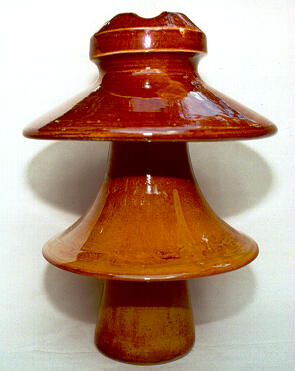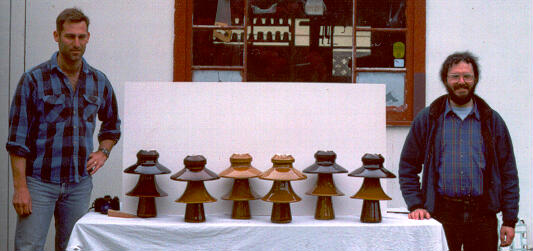 M-3250 is a rare insulator produced by Thomas before about 1910. The
flared middle skirt is referred to as a "lily-shell" and epitomizes the classic
multipart porcelain insulator. This feature was developed by C. C. Chesney and
protected by his patent No. 761,760 granted on June 7, 1904. The patent claimed the
upwardly flared skirt would reflect rain drops upward to wash the underside of the upper
skirt to aid in the removal of dust, dirt, and other contaminates which promoted
electrical surface leakage. In reality, the lily-shell feature aided in wetting the
under surface of the upper skirt which promoted electrical leakage. The greatest
fault with M-3250 was the very deep layer of cement between the bottom and middle
shells. Cement expansion caused by hot summers, heat from electrical leakage, and,
in particular, lightning strikes that produced electrical surges and rapid heating of the
insulator resulted in massive failures when the porcelain shells cracked.
M-3250 is a rare insulator produced by Thomas before about 1910. The
flared middle skirt is referred to as a "lily-shell" and epitomizes the classic
multipart porcelain insulator. This feature was developed by C. C. Chesney and
protected by his patent No. 761,760 granted on June 7, 1904. The patent claimed the
upwardly flared skirt would reflect rain drops upward to wash the underside of the upper
skirt to aid in the removal of dust, dirt, and other contaminates which promoted
electrical surface leakage. In reality, the lily-shell feature aided in wetting the
under surface of the upper skirt which promoted electrical leakage. The greatest
fault with M-3250 was the very deep layer of cement between the bottom and middle
shells. Cement expansion caused by hot summers, heat from electrical leakage, and,
in particular, lightning strikes that produced electrical surges and rapid heating of the
insulator resulted in massive failures when the porcelain shells cracked.
Three dark-colored M-3250's were discovered in an old building in 1994 somewhere in the northeast. The specimen pictured here was in an old collection in the Idaho area and was not reported until 1997. It still has the wooden pin in the pinhole that was sawed off flush with the bottom skirt. The gap between the pin and the bottom skirt is quite small. In 1998, Robin Harrison and Ed Sewall acquired six M-3250's which also had the same wooden pin. These six insulators were installed in western Washington state in 1905 surviving all these years inside a building. Two of the six had beautiful mustard yellow glazes and the three of the other insulators had mustard middle or bottom skirts with contrasting dark brown top skirts.

The photo on the right shows Ed Sewall (left) and Robin Harrison (right) proudly displaying their six M-3250's.

The two insulators pictured here are U-967. Note the glazeweld joint between the two shells and the raised semi-circular ring used to reinforce the joint. Some very early smaller 2-part multipart insulators also have this feature. The "blue-jean seam" can be easily seen inside the bottom skirt. This is a characteristic feature of larger Thomas insulators, particularly multipart porcelain insulators, made prior to about 1910-12. The texture of the denim fabric is very noticeable on some specimens and sometimes the stitching in the seam can be seen. Most insulators with the blue-jean seam feature have either one or two seams but at least one insulator has been reported with three seams. It is believed that Thomas had a problem with the pressing and threading of the bottom skirt where the wet clay would stick to the forming tool during the plunging and threading process. They apparently used a section of a denim pants leg to prevent the clay from sticking to the tool. Another characteristic of very early Thomas manufacture (circa 1901-1905) is the mottled mustard glaze. The glaze soon took on a more orange appearance often mottled with mustard as in the M-3250 shown at the top of the page.